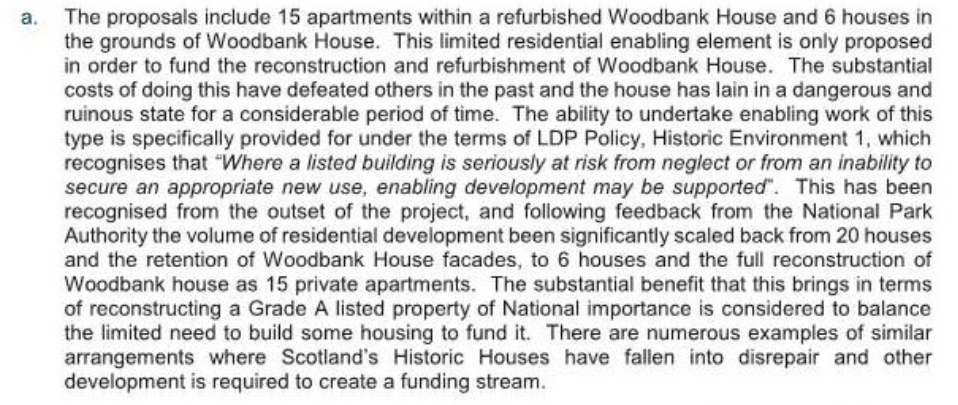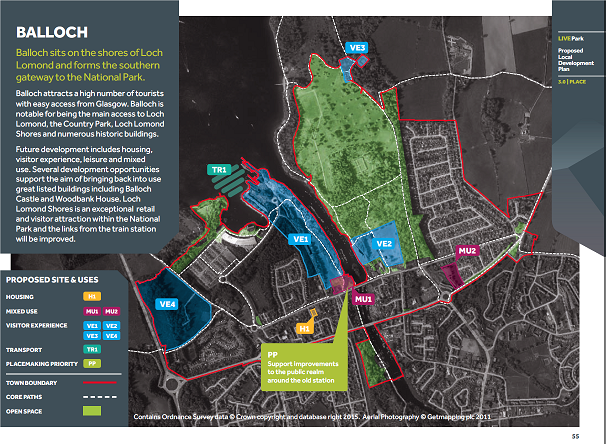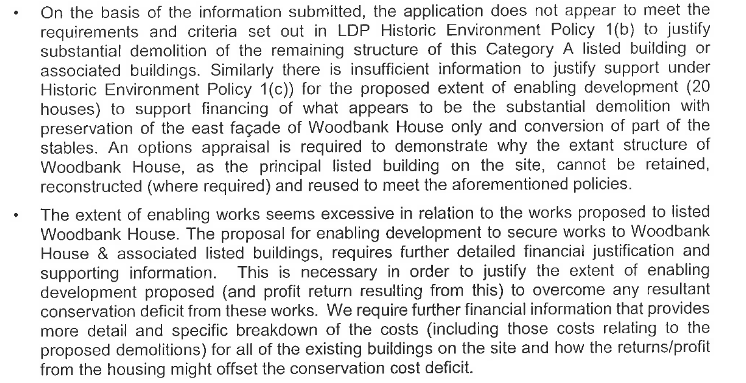The first reason West Dunbartonshire Council gave for objecting to the Riverside and Woodbank House Planning application was that local Councillors regarded it as “overdevelopment and departure from the Local Development Plan”. In planning terms this is very important because Local Development Plans are meant to set a framework for what type of development takes place where – and as importantly where development should not take place at all. Flamingo Land has tried to refute the two main points WDC has made about this. Last week I took a look at Flamingo Land’s claims that it is not true that Drumkinnon Woods had been specifically been excluded from the Local Development Plan (see here). This post takes a look at Flamingo Land’s claim that building housing on the Woodbank House site is not contrary to the LDP either.
WDC’s objection to the Woodbank House part of the site was on the basis that the “applicant seeks to develop areas zoned for tourism opportunities with residential housing”.
Flamingo Land’s response was as follows:

Note how Flamingo Land’s response completely fails to mention that the Local Development Plan had zoned the whole of the Woodbank House site for “Visitor Experience”, the new planning jargon for “tourism”. In effect Flamingo Land’s argument is that they need to build housing on part of the Woodbank House site in order to pay for the preservation of Woodbank House itself, which is a listed building, and they argue this is covered by the LLTNPA’s policy of “enabling developments”.
Enabling development, however, does not need to be housing, whether for sale or otherwise and what Flamingo Land’s response fails to say is that the LLTNPA had already allocated other sites for housing to meet Scottish Government housing targets, including a small site in Balloch.

In fact, while the LDP is short on detail on almost everything, one thing it did say (see above) was “several development opportunities support the aim of bringing back into use great listed buildings…….including Woodbank House” In other words, the tourism was to be the enabling development and a renovated Woodbank House was seen as being another attraction to bring visitors to Balloch. So why does Flamingo Land now need 15 new flats and 6 new houses, which they describe as “a limited enabling residential development” to pay for this?

The references to “conversion of Woodbank House” and “detailed designs of retained facades” in the Design statement are misleading and the next page makes clear what is actually proposed:
“Retention and conservation of the original east (principal) Woodbank House façade, in order to preserve and improve key views from the Old Luss Road”
Flamingo Land in their response to WDC (above) describe this as “reconstruction and refurbishment of Woodbank House”. No, its not! Flamingo Land is proposing to keep one facade and behind this will be a:
“Redevelopment and extension of the property to form [15] new flats”.
So, why are 15 new flats and 6 new houses needed to pay for the retention of this one facade? Indeed given the intensity of the rest of the tourist development being proposed for the Riverside site and Drumkinnon Woods, one might ask why is this NOT sufficient to pay for the retention of not just one facade of Woodbank House but a whole lot more?
To give LLTNPA officers credit, they did ask Flamingo Land to justify the “enabling development” and clarify what was actually being proposed a year ago:

As a result of this intervention, Flamingo Land reduced the number of houses – 20 had originally been proposed as enabling development – to six but added in 19 self-catering lodges. The FOI response then shows that the LLTNPA had to ask again, in an email dated December 2018, for the financial justification for the enabling development:
![]() The FOI response shows the Park then received this information but they have refused to release it, claiming that is NOT in the public interest. That appears wrong. It hard to see how the LLTNPA Board can take a decision about whether the proposed “enabling developments” are justified or not without this information and their decision making process needs to take place in public. What’s more without detailed plans about what is actually proposed – the application is only for planning permission in principle – its impossible to ascertain whether any financial information that has been provided is accurate or not.
The FOI response shows the Park then received this information but they have refused to release it, claiming that is NOT in the public interest. That appears wrong. It hard to see how the LLTNPA Board can take a decision about whether the proposed “enabling developments” are justified or not without this information and their decision making process needs to take place in public. What’s more without detailed plans about what is actually proposed – the application is only for planning permission in principle – its impossible to ascertain whether any financial information that has been provided is accurate or not.
Another fact that Flamingo Land failed to mention in their response to WDC trying to justify this “enabling development” was the price they paid for the Woodbank House. They bought this on the cheap, reflecting the presence of the listed building (a liability in financial terms) and its zoning for tourism (including open space). Parkswatch has previously pointed out that if planning consent is given for any part of the site to be changed to housing that will increase its price significantly making enormous profits for Flamingo Land.
Given all these facts, Flamingo Land’s justification for housing on the Woodbank House site looks just as misleading as their attempt to justify the development of Drumkinnon Woods. West Dunbartonshire Council were right to object to the development as contrary to the LDP. Let’s hope local Councillors hold their ground and ask to address the LLTNPA Board Meeting which will decide the application to make quite sure Board Members are aware of the issues.
Why can’t they just accept it’s a naw just go away leave oie beautiful Loch Lomond alone go find some where else end of
The owner of Flamingo Land, Gordon Gibb, told the Scotsman in 2016 he would drop his plans for Balloch if they were not popular and Ross Greer MSP recently challenged him to keep his word (see here). There is no sign of him doing so yet, however, hence why its important people keep up the pressure on the planners and the National Park
How come the boundary on the river bank got moved all of a sudden to the middle of the river
My understanding is this goes back to 2005 when West Dunbartonshire Council tried to assert its right to own all the River Leven, gifted to the former burgh of Dumbarton by King James V1 in 1609 (see here). However, it decided then to not pursue the case legally effectively leaving half of the river in the hands of Scottish Enterprise Dumbarton and then Scottish Enterprise. Following West Dunbartonshire Council’s objection to the application, perhaps its time they took a further look at the legal case?